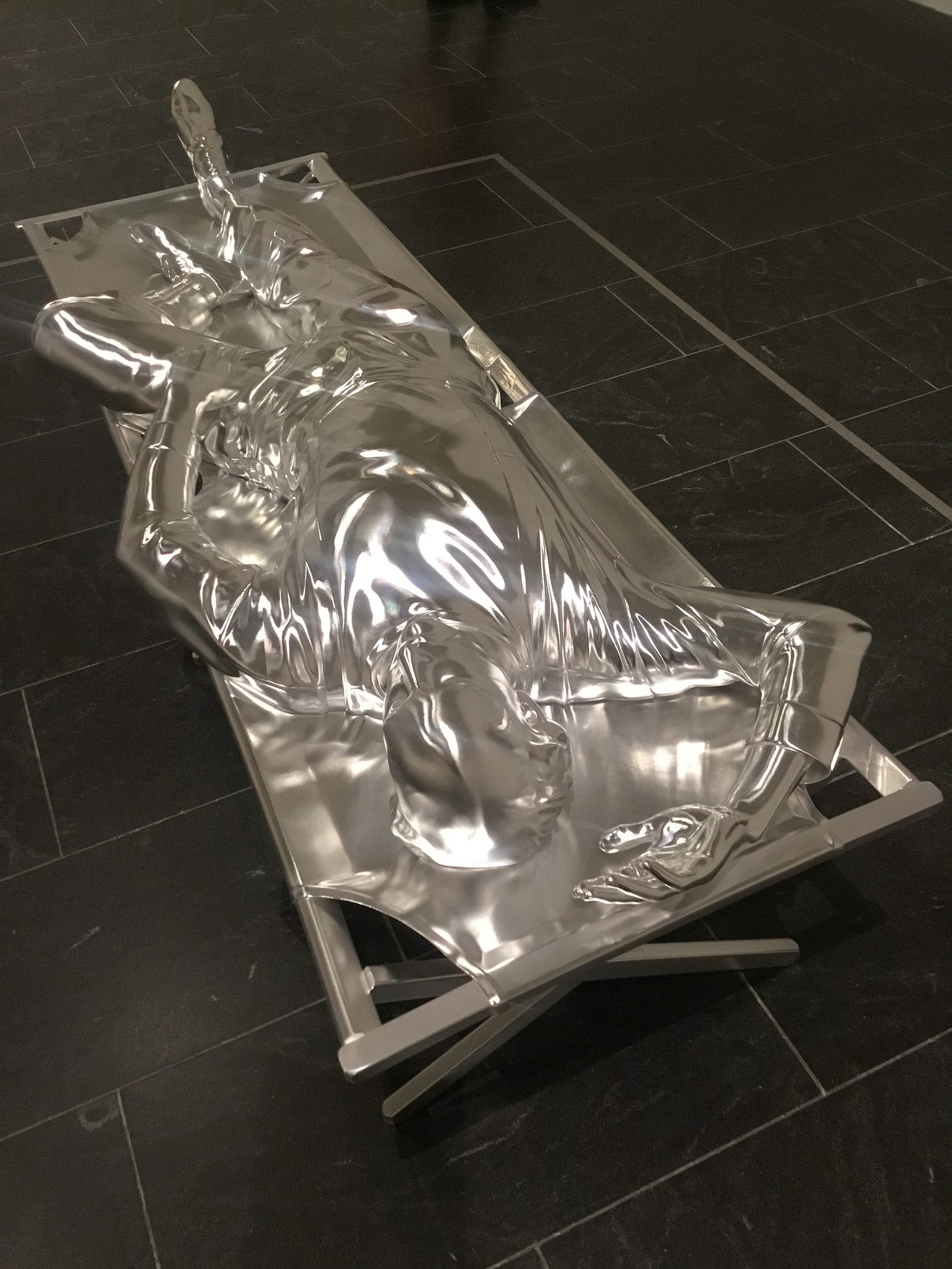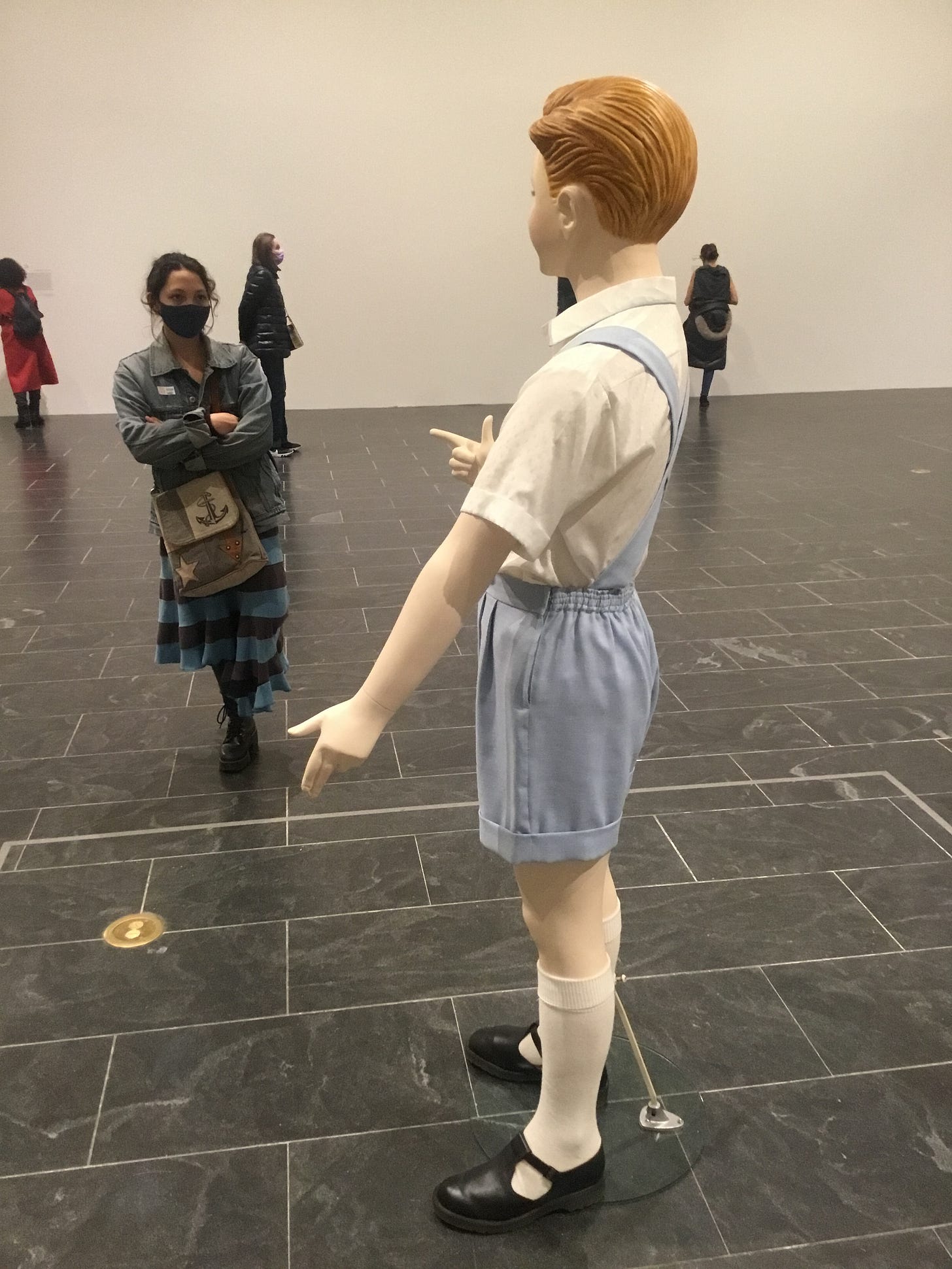Charles Ray: Figure Ground
Two immediate modes of appreciation hit me when looking at Charles Ray’s work. The first is the oddball humor. Plenty in this show. Family Romance is a classic, just as genius as when I first saw it. Plank Piece retains its hold as well. I listened to a podcast of an interview with him, and he comes across as you might expect, kind of kooky and earnest in an endearing way. Seeing the works spanning his whole career, the humor part does decline as you get closer to the present, though the oddball part stays. The second mode of appreciation is more inside baseball: How did he make that? The technical part amazes me, and I suspect he gets a personal charge in knowing that other makers are asking themselves that question when seeing his work. As the works go forward in time, the technical wow-ness does become the stronger impression. And correspondingly my first impression of seeing these later works at the Met was a pulling away.
I was fascinated by a thought voiced by Allison Katz (I think) in a podcast. I think it was her who remarked that artists have generally rejected industrialized methods, against the historical trend of increasing industrialization in other sectors of production. This makes sense to me, but I remember being struck when I heard this. Maybe there’s an artistic intuition that something is lost when industrialized methods become dominant in the making of a work. This fits with my thinking, that our appreciation of an artwork is strengthened when imagining the artist’s moves in creating the work. That is, when we reach out to a work, we are invited to empathetically re-enact the making of the work. (This includes the conceptual moves by the artist, when we engage with the artistic intentions in the work.) This might explain my initial impression that Ray’s work seemed to pull away from me as the more recent work depends more heavily on machine methods.
Ray’s production of work looks measured and deliberate. The works do not come in ‘series’, or ‘variations’ on a theme, though they share common concerns. An idea will take hold, and the execution of the work follows with detail and care. One gets the sense that the founding idea comes intuitively to Ray, similarly to a way a funny or curious thought might cross your mind, and the idea awaits a vision of its final form before it begins to be realized. That’s why I found the works based around Huck Finn thought-provoking, in light of Ray’s prior work. These were two works, Huck and Jim and Sarah Williams. The scale is larger than life-size, about 1.5 times, and they are gleaming silver, like the silver figure in the pic below. Their features are a bit generalized, not particularly individualized — not quite as generic as his mannequin work, but akin to them. This choice fits with the multiple ambiguities presented. In Huck and Jim, Huck is bent over at the waist, his arms seeming to lift something unseen from the ground. Jim is standing next to the hunched-over Huck, with a blank expression, and his right hand is poised, palm-down, just above the small of Huck’s back. Both figures of Huck and Jim are naked. In Sarah Williams, they are clothed, and Jim is kneeling on one knee behind Sarah, attending to a detail at Sarah’s back, who looks to be getting dressed. I had to read the placard to learn that Sarah is Huck in disguise, as I initially took the figure to be female. As with Huck and Jim, there is a slight notion of care from Jim towards his companion. With both these works, there is not an immediately humorous take, so the burn was slower and more curious.
So I felt compelled to read Mark Twain’s Adventures of Huckleberry Finn. That book is a fucking immersive time machine — the dialogue, the evocative descriptions of life on a river, the racism, the violence. Twain’s eye is both embedded in that world and also viewing the world from outside, so the reader picks up on the significant details which you might ignore if you actually lived in it. Having the narrator be the boy Huck gives the reader the same pleasure parents have when seeing events in the world unfold for their children. Anyway, Ray’s choice to use this book was on my mind as I read it. Adventures of Huckleberry Finn is quintessentially American. The dialogue, though delightful, was a bit of a challenge, since it enacts the vernacular and specific verbal tics of each speaker. The words are sounded out, riddled with apostrophes to indicate elided sounds. (This book would seem untranslatable to another language.) The observations on society and character are deft and sharp, and they get at American truths. For example, there is one man’s diatribe against the “guv’ment”. There is also the racism, which smacks you in the face, since it is so pervasive. I can see the choice of this book as source material for Ray being a complicated and provocative one. Huck and Jim dates from 2014, and Sarah Williams dates from 2021. This places the making of Sarah Williams in the midst of our current societal paroxysms on race. In addition, the work draws in thoughts on gender fluidity, encouraged by the title of the work and the feminine depiction of Huck. The year 2014 seems like a different age, considering all we’ve been through since then, but the furies of our contemporary moment did not come out of nowhere, we’ve been billowing in the same resentments and fears for a while now, it only takes one crack to bring it in full force.
Ray is drawing in these forces from today and from our shared, complicated past, and spitting out new images for us to consider. They continue a tradition in art, as we see in ancient sculpture, of imaginatively depicting our shared mythologies. These are concentrated, thoughtful works.





